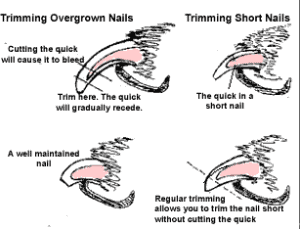When a pet’s nails become too long they interfere with their mobility. Untrimmed nails can also split resulting in a great deal of pain, bleeding, and a trip to the Vet. In severe cases nails can curl under and grow back into a pet’s paw causing a very serious and painful infection. We have seen this happen a few times at Hair of the Dog.
We get many requests from customers to trim their dogs toe nails as short as possible. Depending on the frequency of visits to us for toe nail trims, this may or may not be possible. We hope this information about dogs toe nails will help you understand why its important to visit us anywhere between 2-6 weeks for trims. To make this easy for you, we offer a free toe nail trim in between your pets regular grooming appointments.
The quick is the living part of a pet’s nail and has blood vessels running throughout. Cutting into the quick during nail trimming is painful and will result in bleeding. An important fact to note is that the quick grows with the nail. As pet’s nails grow longer the quick will also lengthen. So if your pet’s nails are overgrown you will not be able to clip the nails to the desired length without cutting into the quick. As the tips of the nails are frequently trimmed, over time the quick will shorten. One indication that your pet’s nails need a trim is when they begin to curve. And if you hear a clicking or tapping sound as your pet walks across a bare floor it’s definitely time for a nail trimming. And don’t forget the dewclaws: they are the nails located on the inside of the leg just above the paw. These nails don’t touch the ground, so they don’t wear down as fast as the others as your dog walks on rough surfaces. Splitting, breaking, and ingrown nail problems are very common on the dewclaws. We’ve seen them grow around into a complete donut. Worse, we’ve seen them grow right into the dog’s leg, causing pain and abscesses.
To make this regular grooming habit less stressful, familiarize yourself with your pet’s feet. Hold them and touch them regularly so that your pet is comfortable with you touching their feet and nails. Most pets are sensitive in that region. Grabbing and holding tightly to the foot is painful – much like someone grabbing your hand like a handshake and then squeezing your knuckles together. It is best to grasp the leg firmly at the first joint instead of just the foot. Gently rub the feet and spread the toes to get your dog comfortable with being touched on his feet. This practice is even more important if your pet has had the quick cut before and is already frightened by the job. Rewarding your pet for positive behavior is an important part in your pet’s acceptance of the activity. It’s always best when your pet can associate the attention you lavish on him or her with a positive, happy memory.

